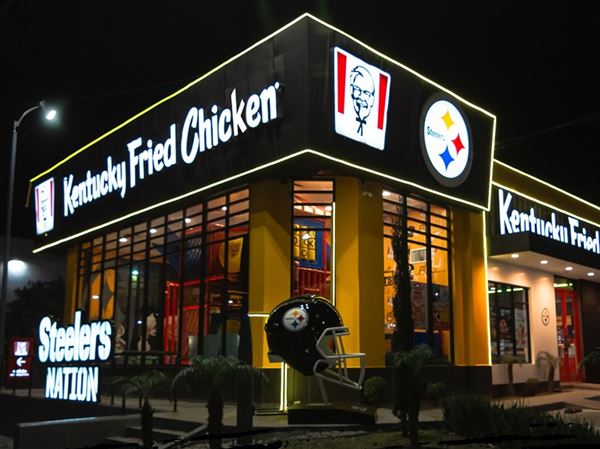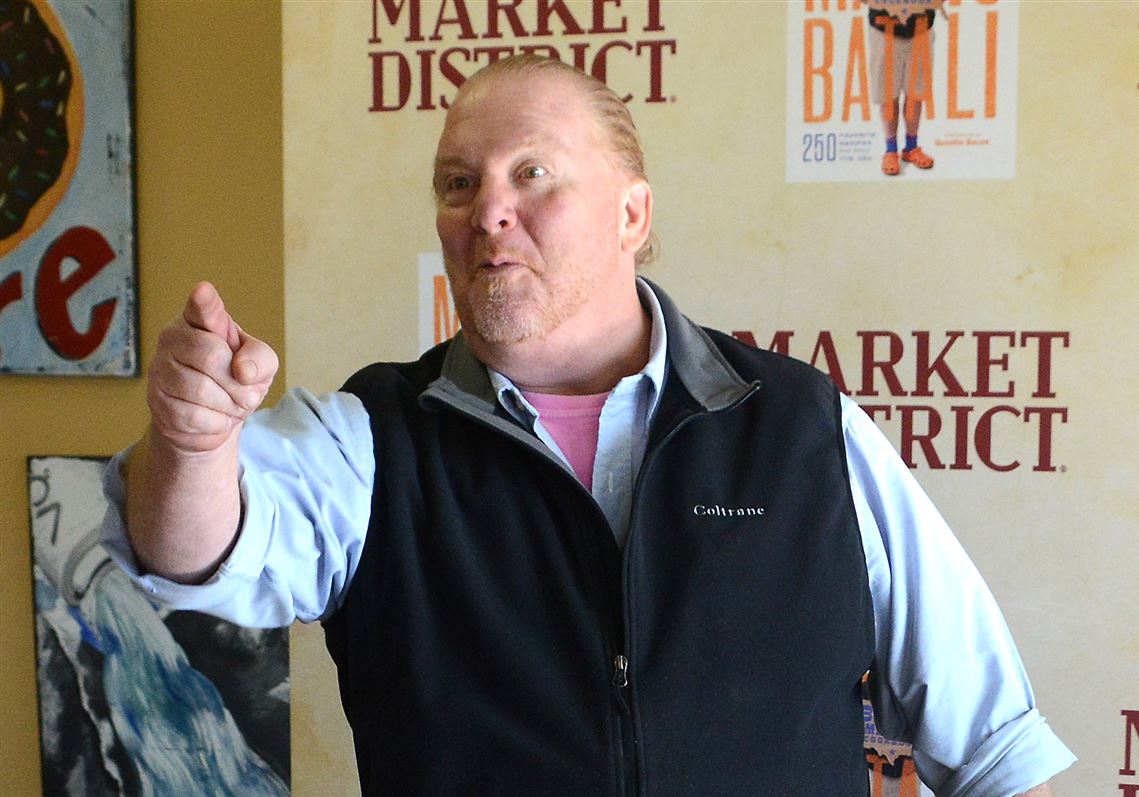Mario Batali has a self-definition for “Molto Mario”: Intensely curious, never resting and always looking for authenticity.
“Molto Mario” translates to very Mario in Italian and was the title of his late show on Food Network, but the words have stuck to describe him. Mr. Batali said his passion and excitement often overcome what a lot of people would consider sacred. “Food is not sacred. It is of the people and is made everyday by everybody who lives,” he added. When he gets excited about recipes, it’s because they are old — not new and definitely not something that is made “on the whim by some punk.”
The chef-author-restaurateur was at Settler’s Ridge Market District in Robinson Saturday to chat and have photographs taken with the 700 fans who had lined up to see him after signing their copies of his latest book, “Big American Cookbook,” which came out last October and features 250 recipes from across the country.
He had flown in from his home in Greenwich Village in New York City a little after 9 that morning and was heading back to the Big Apple after the meet-and-greet so that he could carry out his chef responsibilities at his restaurants Eataly NYC, Babbo and finally Casa Mono — all in the same evening.
Before he met with his fans, Mr. Batali spoke candidly about his 10th cookbook, Easter feast plans, his signature dish and outfit, dislike for waiting in line, penchant for loud music, recent harsh review on Babbo in The New York Times and anonymous critics.
Q: What inspired you to write the “Big American Cookbook”?
A: When I was traveling around the country in the last 15 years, I discovered all these beautiful and traditional dishes — not necessarily fancy or expensive, not necessarily hard to shop for, but ones that spoke to me of the very specific place where they were born. I divided the country into eight regions, and there’s a lot of crossover — there’s chili, seafood chowder, barbecue and casserole-y kind of things in a lot of places. So we broke it down to what makes a lot of sense.
Q: Is there a region that surprised you?
A: In terms of deliciousness, it’s the Southwest. I just like the chilies, the cultures of Latin America, Texas, Nebraska and kind of the West all coming together in one spot.
Q: And which region should get more recognition but doesn’t?
A: The Midwest. When you have a walleye sandwich near Lake Michigan, it’s something remarkable. If you go to West Side Market in Cleveland and eat the mainstays of the Eastern European deli culture, it kind of knocks you out.
Q: Easter is around the corner. Do you have any recommendations?
A: [He flips through the cookbook pages to find dishes.] I would have a Dungeness crab quiche for Easter. I wouldn’t have a barbecue beef brisket. But you know what’s really cool? Those toasted ravioli would make a great first course. [He points to the Toasted Ravioli From the Hill recipe.] Crawfish pie would be a great idea. I won’t want a turkey sandwich. I would do the stuffed vidalia onions. This is a bott boi [referring to the Slippery Pot Pie recipe], which is like a pot pie — you use pasta on top and then toss it under a broiler.
Q: And desserts?
A: What is probably most revolutionary for my brand in this book are the desserts. There are a lot of them, and I have never really done them so much. I am not that talented at making them. But the American culture of desserts is simple — like the Indian pudding or any one of those 32 pies. They are not hard to do and and serve up in a beautiful way.
Q: Are you going to cook for your family on Easter or will someone else be taking over?
A: I always do the cooking for the holidays. In my house we will have ham, tortellini Alfredo, sauteed ramps and asparagus with duck egg.
Q: When you are on book tours like this one, what do you do when it comes to chow time?
A: Here? I am going to get one of those panini or sushi downstairs. I don’t go for fast-food chains ever. I don’t know where they get their stuff. I’m pretty sure they are mechanized and I like hand-made. At this point in America, there is always a good taco in town and always a place that has a good carved sandwich.
Q: Have you explored the culinary scene in Pittsburgh?
A: I love Primanti’s, but Pittsburgh has grown up since. I like Butcher and the Rye and the sandwiches at Szmidt’s Old World Deli [it closed in September 2015]. And Lidia’s [in the Strip District], of course.
Q: Do you ever give advice to your restaurant partner Lidia Bastianich?
A: I get lots of advice from her but I never give her any. She is much wiser than I. I mean, she’s Lidia. We worked together this week a couple of times tasting stuffed and strand pastas at Del Posto [They co-own the restaurant in New York City.] We are working on new signature dishes. We don’t take her suggestions blindly but we try everything she says and see if it works for all of us. It’s a collaboration.
Q: Have you ever thought of opening a restaurant here?
A: Lidia’s is already here, and competing against my mother-in-law will be a problem. [Laughs] I will come and support it.
Q: You are all over the map, and have restaurants in New York, Las Vegas, Boston, and even Singapore.
A: The only reason we open new restaurants is when one of our sous chefs is so good and wants to work for somebody else or wants to open their own restaurant. I say, “Great. You want to go back to your own hometown?” That’s why we are in Los Angeles, Vegas, Singapore, Westport [Conn.], Port Chester [ N.Y.], Boston. We don’t look at a map and say, “this place looks like it is fertile ground for investment,” because we are not about that kind of a growth.
Q: How do you come up with a menu at each one of those cities?
A: We create a menu that makes sense to us. We use local products in a way that maybe the locals don’t. We don’t adhere to importing everything from Italy because Italians in Puglia don’t use the same ingredients as Italians in Veneto. As a matter of fact, they don’t like the ingredients from the other region. We support the local city as we want the flavor to be that specific.
Q: Where do you go out to eat?
A: In New York City, basically you draw a circle for half a mile around your house, and you go to those. So my favorite is a place called Pearl Oyster Bar, a Maine-style lobster bar. I also like Tertulia, a tapas place, and Num Phang, a Cambodian-Thai-inspired sandwich shop. I go to David Chang restaurants because everything he does is perfect. I don’t really make reservations too far in advance.
Q: Do you ever wait in line at restaurants?
A: I don’t really like waiting in line. There’s a place in New York City called Tim Ho Wan, a dim sum place from Hong Kong. People wait like 2 hours. I say get something else to do. I would go to the next best place with no lines.
Q: What is a signature Mario Batali dish?
A: Anything from antipasto to something as elaborate as beef cheek ravioli with squab liver and black truffles to something as simple as linguine with clams, hot chilies and a little bit of garlic. I’m pretty seasonal. This week, I will probably have asparagus with duck egg. I will just blast the asparagus and let it stay at room temperature. Then on a sunny side-up egg, I will add a little salt and some Parmigiano-Reggiano. That, for me, is a perfect dinner along with a glass of prosecco or Champagne.
Q: I have to ask you about something else that is signature Mario Batali — your wardrobe. You started the orange movement.
A: Orange is a very happy color. But the real basis was when my children were 2 and 3, and I had them for the very first time alone, away from my wife. We went down to the Houston ballfield [William F. Passannante Ballfield], which in any other city would be called a parking lot because it’s concrete surrounded by a chain-link fence. There were about 500 kids playing in this one block, and they were all wearing black or gray, because that’s cool. My kids were wearing black or gray because they thought they were cool. I was sitting with my friends when one of them asked me where my kids were. I look over a sea of children and don’t see them. My heart stops. I casually walk around like nothing’s wrong. But after 15 minutes I start to realize that there is something wrong. “This is it, I have lost my kids. I’m totally screwed. Somebody stole them.”
Ten minutes later, we found them. And the next day, I bought them orange and red jackets. I always wore orange shoes but suddenly it became a signature color. If you ask my children, “Why are you always wearing orange?” They’ll say, “It’s the national color of Batalis.”
Q: But do you feel comfortable being in those Crocs all day long?
A: Don’t I look comfortable? [a wide smile] My design is not for fashion blogs. My design is pure comfort. It doesn’t really bother me that I’m not that popular on Vogue Teen.
Q: What do you tell people who complain about the loud music in your restaurants?
A: I tell them that there are quiet times and loud times in every restaurant. If you love the food, come at 5:30 or 6 o’clock. We have quiet restaurants — we have Del Posto and [He thinks, pauses and then repeats.] Del Posto, that’s our quiet restaurant. [Laughs] But we don’t blast it like I used to. It’s loud and vibrant because when you walk into one of my restaurants you know you are not anywhere else; you are in New York City and the vibe and energy is palpable and impressive.
We have evaluated every single detail from how the door is painted to the way the floor feels when you walk in to the lighting to the fabric on the chairs to the kind of plates we have to the olive oil to the salt to the kind of coffee we have to the kind of milk we use to the way we say hello to the way we say goodnight. So you think we are not thinking about the music, too? It’s a curated experience, and it is what we want. Every critic writes about it but there are a lot of people out there who are not critics.
Q: Speaking of critics, Pete Wells of The New York Times came down hard this week on Babbo.
A: Yes, he did. When I was a kid I would have said [expletive] you. But at this point in my life, I ask, “What can I learn from this?”
Maybe the guinea hen skin wasn’t crisp. His issue about having to wait longer is valid. But that said, we are not a restaurant that has a giant waiting room that is empty so that everyone can feel comfortable. We are trying to make it in a crowded field.
Q: What about the overbooking?
A: We have to overbook because a lot of restaurateurs are faced with people who just call but never show up. We can’t afford to have empty seats. Rents are going up, food is costing more and there’s an ominous feeling in the country right now about the new administration. For us, it’s about survival and being sustainable. We have to take little risks at certain points to make sure the restaurant will survive. It would be easy just not to do well, but we are fighters.
I will take Pete Wells’ criticism. It’s sad that after 18 years of being a three-star restaurant we are a two-star restaurant. But in our hearts we know we are delivering the exact same thing.
The print medium is struggling with where it has got to be and in the face of quicker and more valiant criticisms on web platforms there will be a settling. And the old guard of the super print heroes is a little less important.
Q: But do you really want the Yelpers and phantom critics to be the voice of reason?
A: On TripAdvisor, we do really, really well. I don’t know whether I can really measure Yelp. Anonymous criticisms don’t bother me at all. I don’t care because I don’t read them. If you are not going to put your name on it — and I mean your name — not Whiz Kid or Mr. Spaghetti, you are hiding behind something. As far as I am concerned, you might be my competitor just trying to take me out. If you are going to put your name, I want to read it.
Q: Are you worried how reviews will affect your business?
A: I would just say Guy Fieri’s restaurant that got one of the most hilarious and nasty reviews of all time [in The New York Times by Pete Wells] made $17 million last year in New York City. So as great and as fun as it was to read, and I love Guy, it didn’t affect his business. Because The New York Times is The New York Times; it is not the national record.
But that said, I like Pete Wells and I think he does a good job. So what we can learn from him can be a very valuable experience.
Q: If someone has a bad experience at one of your restaurants, what do you say to the person?
A: Talk to the manager. Say what the problem is, and we will fix it. Our intention is not to create a bad experience but a good one. We are hospitality professionals. This is all we think about, except for rock ’n’ roll. So if you give us a chance to fix it there, you might walk away with a good experience instead of feeling angry or bitter. Don’t just storm out in a huff because your martini didn’t have a certain number of olives in it. Tell us, we’ll add the olives.
Human error happens because we are human. I’m not proud of human error but I’m also not going to fire my staff because of it, unless they make it a hundred times.
Arthi Subramaniam: asubramaniam@post-gazette.com, 412-263-1494 or on Twitter @arthisub.
First Published: April 12, 2017, 4:00 a.m.


















